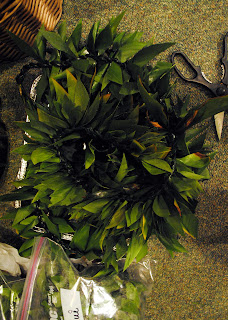We all showed up to kumu's around 6pm for our 3-hour work session. Each of us needed wrist and ankle lei, called kupe'e. Since these are easiest to prepare, Leialoha wanted the newbies to start here, so she showed a few of us the twisting technique. Four or five of the dozen people in attendance have already made these simple kupe'e. To make, two ti leaves are knotted together and placed between the big and second toe. Pulling taut, the right hand twists the leaf to the right then crosses it over the left. This process continues until a new leaf must be added on for length. When the desired length is achieved, another knot is tied. Kumu wanted these to wrap around our ankle/wrist twice. These pieces took only about 45 minutes to make.
Next, Leialoha began demonstrating how to make the lei. She was one of two people who knew how to do this. This process was more complicated than making the kupe'e and made easier when working in pairs. After we'd cut a pile of leaves into smaller strips, Lani and I were ready to begin. This lei begins with two leaves being knotted together. The twisting is the same as for the kupe'e, only after every other twist, 3 pinched ti leaf strips are added in. This is the hardest part to do one-handed. I did all the twisting and pulling while Lani handed me the 3 pinched leaves. Though I did the brunt of the work, it was still quicker than making it all on my own. Each of these lei had to be six feet long and took roughly an hour to make.
Kumu is on the far right.
Taking these pictures with my left, sticky hand, was not easy.
Lani and I worked feverishly to complete her lei in less time than it took to make the first one. We did a good job and cut off a little time. Meanwhile, the older ladies in the group took to telling somewhat inappropriate stories, giggling to themselves and causing brows to raise. It was quite funny. Kumu is not bashful, that's for sure!
Leialoha was able to show four of us how to make the lei po'o, the spiky head wreath. I was pretty disappointed to find out that it's the most difficult to make. At 8:45pm, covered in green goop, with incredibly stiff muscles, and an empty stomach, I was not excited to be undertaking the biggest challenge of the night. And, most of Lani's leaves and mine had been used by those around us, so we were left with extra cutting and preparing for much longer than others. Boy, Lani was irritated at that! I had been looking forward to this new experience, but my aching muscles were distracting me from enjoying much of the project.
The lei po'o is a braid, not a twist. Three ti leaves are knotted together, placed in between the toes and braided for an inch or so. This is where it gets very tricky. Two cut, pinched ti leaf strips are placed in the braid. One long strand ti leaf crosses over, the small pieces are then folded up (in half) then another set of two ti leaves are pinched and added. It's not intuitive and super easy to mess up, especially when adding in leaves to make the strands longer. A lady sitting next to me (can't remember how to say her Hawaiian name) got about 6 inches in when she got stuck. Leialoha tried to help but ended up having to take it all apart and restart.
Lani and another lady worked together, and I made mine by myself. We were all getting cranky and sore. Finally, just before 10pm, I finished my last piece. I helped clean up a bit then began the drive back over the mountains. Boy, did it feel good to sit in a seat! My back! Ouch! I was relieved that the traffic home was light, even near our house where the APEC craziness is in full swing.
My pile of lei.




